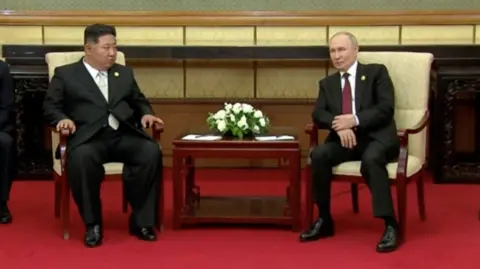The authorities in China have officially commenced the construction of an ambitious hydropower dam project on the Yarlung Tsangpo river located in Tibet, which is set to become the largest of its kind globally, surpassing the Three Gorges dam. Premier Li Qiang led the groundbreaking ceremony for the Motuo Hydropower Station, amidst a backdrop of rising tensions with neighboring India and Bangladesh.
This massive undertaking, with a cost forecasted at approximately 1.2 trillion yuan ($167 billion), has incited fears in India and Bangladesh regarding potential disruptions to water supplies for millions of people living downstream. The Yarlung Tsangpo river, flowing from the Tibetan plateau, is crucial for both nations, feeding into major rivers such as the Brahmaputra and Siang.
Local government officials in Arunachal Pradesh, India, including Chief Minister Pema Khandu, have expressed dire apprehensions, fearing that the dam's operation may drastically reduce river flow, endangering livelihoods and disrupting local ecosystems. Khandu described the project as a significant threat, warning that sudden water releases from the dam could devastate communities in the Siang region.
The Indian Ministry of External Affairs previously noted its concerns to China about large-scale hydropower projects that could impact upstream river flow, emphasizing the need for transparency and cooperation with downstream nations. India is also considering its own hydropower projects to mitigate potential flooding threats posed by China's dam.
China's response to these concerns has included assertions of its right to develop the river's resources while reportedly considering downstream consequences. Meanwhile, Bangladesh has also reached out to Beijing for more data about the dam's potential impacts.
Notably, the site of the dam is positioned in the Yarlung Tsangpo canyon, acclaimed as the deepest canyon on Earth. The complexity of the project includes plans to construct tunnels through the Namcha Barwa mountain to redirect segments of the river. Additionally, the electricity generated is intended for transmission to China's eastern regions, supporting urban development while promising enhancements to the local economy.
This project sits within a broader context of China's strategic push to capitalize on its Himalayan rivers for hydropower, rooted in a policy initiative meant to channel energy from western regions toward its eastern metropolises. Critics, however, claim that such endeavors exemplify China's pattern of exploiting Tibetan land and resources, often disregarding local communities and their environment.
Past efforts to develop dams in the region have led to significant protests among Tibetan communities, met with harsh crackdowns from Chinese authorities. Environmentalists continue to raise alarms about the potential flooding of habitats and the geological hazards associated with damming in seismically active areas.
The geopolitical implications of this development illustrate how crucial water management and environmental stewardship are as Asia faces shifting climate patterns and resource pressures, making collaborative approaches increasingly essential.
This massive undertaking, with a cost forecasted at approximately 1.2 trillion yuan ($167 billion), has incited fears in India and Bangladesh regarding potential disruptions to water supplies for millions of people living downstream. The Yarlung Tsangpo river, flowing from the Tibetan plateau, is crucial for both nations, feeding into major rivers such as the Brahmaputra and Siang.
Local government officials in Arunachal Pradesh, India, including Chief Minister Pema Khandu, have expressed dire apprehensions, fearing that the dam's operation may drastically reduce river flow, endangering livelihoods and disrupting local ecosystems. Khandu described the project as a significant threat, warning that sudden water releases from the dam could devastate communities in the Siang region.
The Indian Ministry of External Affairs previously noted its concerns to China about large-scale hydropower projects that could impact upstream river flow, emphasizing the need for transparency and cooperation with downstream nations. India is also considering its own hydropower projects to mitigate potential flooding threats posed by China's dam.
China's response to these concerns has included assertions of its right to develop the river's resources while reportedly considering downstream consequences. Meanwhile, Bangladesh has also reached out to Beijing for more data about the dam's potential impacts.
Notably, the site of the dam is positioned in the Yarlung Tsangpo canyon, acclaimed as the deepest canyon on Earth. The complexity of the project includes plans to construct tunnels through the Namcha Barwa mountain to redirect segments of the river. Additionally, the electricity generated is intended for transmission to China's eastern regions, supporting urban development while promising enhancements to the local economy.
This project sits within a broader context of China's strategic push to capitalize on its Himalayan rivers for hydropower, rooted in a policy initiative meant to channel energy from western regions toward its eastern metropolises. Critics, however, claim that such endeavors exemplify China's pattern of exploiting Tibetan land and resources, often disregarding local communities and their environment.
Past efforts to develop dams in the region have led to significant protests among Tibetan communities, met with harsh crackdowns from Chinese authorities. Environmentalists continue to raise alarms about the potential flooding of habitats and the geological hazards associated with damming in seismically active areas.
The geopolitical implications of this development illustrate how crucial water management and environmental stewardship are as Asia faces shifting climate patterns and resource pressures, making collaborative approaches increasingly essential.





















